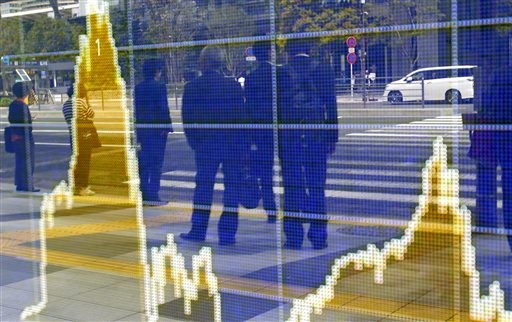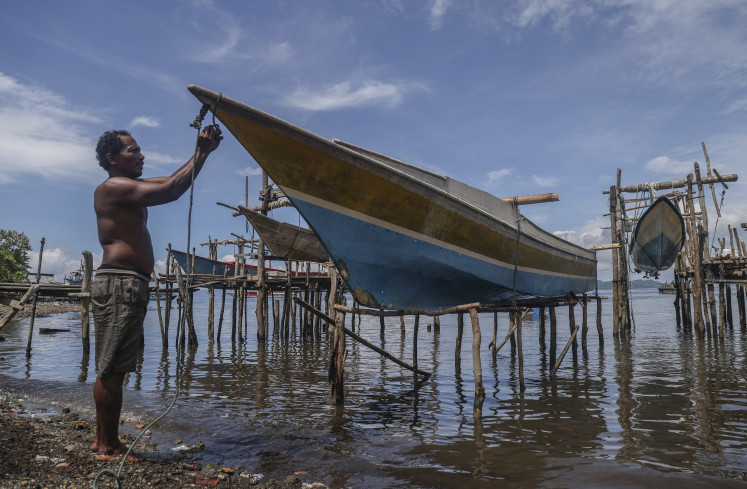Popular Reads
Top Results
Can't find what you're looking for?
View all search resultsPopular Reads
Top Results
Can't find what you're looking for?
View all search resultsBalance of payments and external risk
The Q1 2016 balance of payments showed that [...] companies are losing their appetite to invest abroad.
Change text size
Gift Premium Articles
to Anyone
 Slowing growth -- In this April 8, 2016 file photo, people are reflected on the electronic board of a securities firm in Tokyo. The IMF on Tuesday, April 12 downgraded its outlook for growth for most regions and for the global economy as a whole. It now foresees a weaker financial landscape than it did in January. Like the World Bank and the Organization for Economic Cooperation and Development, the IMF has repeatedly overestimated the strength of the world economy in the aftermath of the 2008 financial crisis. (AP/Shizuo Kambayashi)
Slowing growth -- In this April 8, 2016 file photo, people are reflected on the electronic board of a securities firm in Tokyo. The IMF on Tuesday, April 12 downgraded its outlook for growth for most regions and for the global economy as a whole. It now foresees a weaker financial landscape than it did in January. Like the World Bank and the Organization for Economic Cooperation and Development, the IMF has repeatedly overestimated the strength of the world economy in the aftermath of the 2008 financial crisis. (AP/Shizuo Kambayashi)
A
s the Indonesian government struggles to accelerate the construction of infrastructure projects and cope with the shortfall in tax revenues, it is also facing the risk of external vulnerabilities stemming from subdued global growth, low commodity prices and weaker trade and investment flows. Some of these external risks have been reflected in the recent Indonesian balance of payments figures.
The deficits in the current accounts have been declining since 2014 although are still large in terms of percentage of GDP.
The merchandise trade continues to be in surplus although the amounts have continued to decline, rendering them unable to make up the deficits in services and incomes.
At the current level of deficits in services and income, the trade surplus must reach around US$25 billion in order to get the current accounts in surplus.
Therefore, as long as its trade surplus is well below the deficits in services and incomes, Indonesia’s current accounts will continue to be in deficit.
Unfortunately, these deficits cannot be covered by Foreign Direct Investment ( FDI ).
Since 2012, FDI figures have been only roughly half of the current account deficits.
This makes the Indonesian balance of payments highly vulnerable to capital outflows if there are volatilities in the financial markets.
The trend of balance of payments has been exacerbated by the continuing decline in exports since 2012.
In 2015 exports dropped by $26 billion, the largest decline in the last four years.
Interestingly, the decline of exports to China was not the main cause of the fall in exports as many have assumed. Exports to China fell by only $2.6 billion.
In comparison, exports to Japan fell by $5.1 billion, to Singapore by $4.1 billion and to South Korea by $3 billion.
Last year the stagnant economies of Japan and Singapore had a more severe impact on Indonesian exports than the lower growth in China.
Oil exports to those countries fell not only because of the sharp drop in oil prices but also because of lower volumes as demand for oil slowed. The decline in oil exports accounted for $12 billion of the $26 billion drop in exports, or nearly 50 percent of the total.
The decline in oil and gas exports was the biggest contributor to the decline of Indonesian exports in 2015. As such, as long as oil prices remain low, Indonesian exports will remain weak in the short and medium term.
The balance of payments also showed how the tumultuous year of 2015 has impacted the Indonesian economy.
Volatilities in global financial markets eroded investor confidence and Indonesia suffered a reversal of capital flows, and sharp depreciation of the rupiah in the third quarter ( Q3 ) of 2015.
Portfolio investment turned sharply into deficits of $2. 2 billion in Q3 2015 from a surplus of $5.6 billion in Q2 2015.
For 2015 as a whole, portfolio investment dropped by $9.4 billion to $16.7 billion.
But this was largely due to a significant fall of portfolio flows that went to the private sector.
The portfolio investment that flowed into government bonds remained strong. It went up from $15. 4 billion in 2014 to $17.4 billion in 2015.
In Q1 2016, the government raised $3.5 billion from bond sales, including $2.3 billion from Islamic sukuk bonds.
Portfolio investment has flowed back into Indonesia, probably attracted by the modest but still respectable Indonesian growth, as well as its higher returns compared to other emerging markets.
In this regard, Indonesia performed better than 30 other emerging economies tracked by the Institute of International Finance.
During the course of the year, the government will likely be more aggressive in issuing foreign currency denominated bonds to plug its rising budget deficits, which are forecast to hit 2.5 percent GDP from a projected 2.1 percent of GDP due to a large shortfall in tax revenues.
Volatilities also hit the Jakarta Stock Exchange ( JSE ) in 2015. Scared by the prospect of a US Federal Reserve interest rate hike and slowing economic growth in Chine, investors withdrew $1.5 billion from the JSX, bringing the Jakarta Composite Index down by 15 percent.
With the prospect of the Fed rate increase gone, the JCI stabilized in Q1 2016 as foreign investors returned and made a “net buy” of stocks totaling $314 million, pushing the JCI up by 5 percent during the quarter.
The negative ( -$2.4 billion ) balance in “other investment” showed that Indonesia-based companies are still deleveraging, focusing more on paying their overseas debt rather than drawing more debt.
They do not see big prospects for their businesses in the still-weak economy, or they are concerned with the extent of the rupiah depreciation, which could impose a higher debt burden.
Consequently, they feel that trimming their overseas debt burden early is the best solution amid the uncertainty.
Deleveraging means businesses are curbing their investment activities. The Q1 2016 balance of payments showed that Indonesia-based companies are losing their appetite to invest abroad.
Their investment abroad slowed to a trickle, only $0.09 billion, compared with the robust $2.2 billion in Q1 2015.
The $2.2 billion net foreign direct investment figure in Q1 2016, was the highest compared with previous quarters, but this was due to a sharp drop in Indonesian companies’ investments abroad.
The gross inflow of foreign investment actually declined significantly to $2.3 billion from $3.8 billion in Q1 2015, the lowest level compared with previous quarters.
This showed that foreign investors still have no enthusiasm, or were still maintaining their “wait and see” attitude before making commitments to invest in Indonesia, despite deregulation measures and several economic packages offered by President Joko “Jokowi” Widodo.
In these kinds of environments, the loose monetary and fiscal policies the government has pursued so far are not enough to do the trick.
The government’s ability to speed up capital spending and to seriously reform bureaucracies is also crucially important to gain investor confidence.
***
The writer is a commissioner in a publicly listed oil and gas service company. The views expressed are his own.
---------------
We are looking for information, opinions, and in-depth analysis from experts or scholars in a variety of fields. We choose articles based on facts or opinions about general news, as well as quality analysis and commentary about Indonesia or international events. Send your piece to community@jakpost.com.









